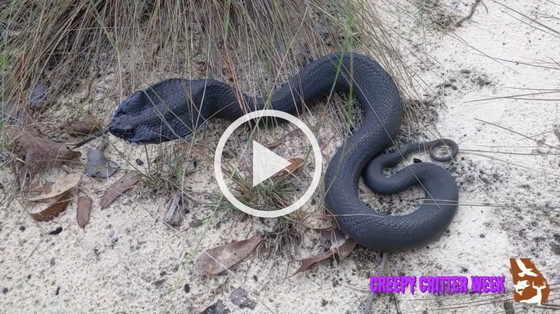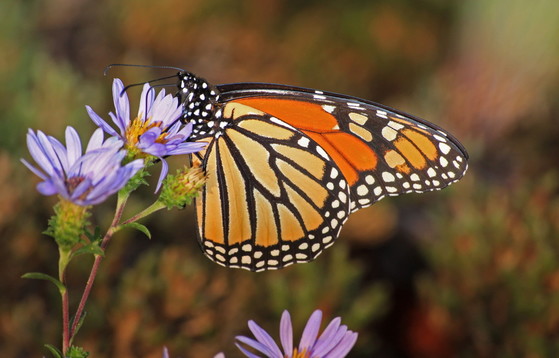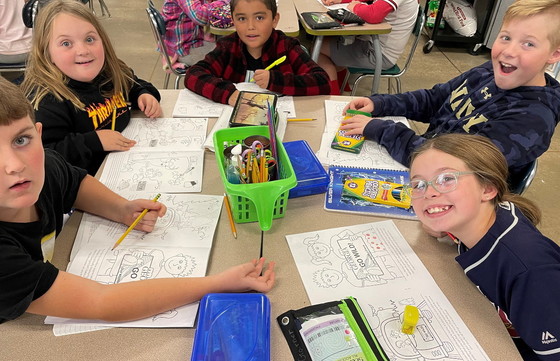IN THIS ISSUE
- Hognose drama
- Looking for monarchs
- A fall splash of sassafras
 When it comes to acting, the eastern hognose snake beats them all.
This video by Dr. Vanessa Lane of Abraham Baldwin Agricultural College shows what a hognose will do to convince possible predators that the snake is a) dying or b) simply a smelly, deranged mess that is best avoided.
DNR senior wildlife biologist Daniel Sollenberger explained that when threatened the hognose’s first response is usually to hiss, spread its head and bluff striking. But that defense can quickly devolve into defecating and emitting musk, thrashing wildly, and – finally – going limp as if dead.
It’s not known why hognose snakes employ thanatosis, the defense of playing dead, or if the reaction is involuntary (i.e., feinting goats). But apparently it works.
Many other snake species sometimes go limp when handled, Sollenberger said. “But not many of them do it as dramatically as the hognose.”
‘DEATH DANCE’ DRAWS A CROWD
The hognose video went viral when posted on Facebook by DNR'S Wildlife Resources Division. Shared by outlets varying from WSB-TV in Atlanta to USA Today, the post logged 57 million views. According to social media specialist Denise Shepherd, it also yielded a welcomed response among many viewers who said although once no fan of snakes they now had a favorite one.
 Monarch butterfly (Alan Cressler)
Last winter, volunteers from across the Southeast reported more than 5,800 sightings of monarchs.
This winter, Monarchs Overwintering in Southeastern States – a partnership of universities, agencies and other organizations – is again asking for the public’s help in reporting sightings from the Carolinas through Georgia, Florida, Alabama, Mississippi, Louisiana and Texas.
UGA ecology professor Sonia Altizer, director of Project Monarch Health, said the data can help scientists determine if these iconic but declining butterflies can overwinter as non-breeding adults in the southern U.S., “and how this might affect future population numbers.” The observations could also be key to documenting how winter-breeding activity may be affecting their annual migration to Mexico.
Understanding migration and overwintering behavior is crucial to conserving monarchs, a candidate for listing under the Endangered Species Act.
Thousands of monarchs stream across the South each fall on their way to wintering grounds in central Mexico. In the spring, this eastern population of the butterfly returns to the U.S. and Canada to breed.
But not all monarchs migrate to Mexico. Volunteer observations over the last two decades have helped scientists better understand how and why some monarchs breed throughout the winter in the southern U.S. Scattered reports also suggest that monarchs can overwinter in coastal regions in a non-breeding state, similar to their wintering behavior in Mexico.
DNR wildlife biologist Anna Yellin said project partners are grateful to all who report sightings. “When we come together as a community as we have with this effort, we stand a better chance of protecting the monarch for future generations.”
HOW TO REPORT SIGHTINGS
It's as easy as ...
- Create a free account at journeynorth.org/reg.
- Get details on reporting monarch sightings at journeynorth.org/monarchs.
- Dec. 1-March 1, submit monarch observations at journeynorth.org/sightings.
PLATES THAT PROMOTE WILDLIFE
An additional way to help monarchs and hundreds of other native Georgia wildlife species is to buy or renew a DNR monarch and Georgia aster license plate. By state law, sales and annual renewals of these and other DNR “nongame” tags, including the eagle and hummingbird designs, dedicate up to 80 percent of the $25 specialty plate fee to conservation. Learn more.
 Small but bold, sassafras adds to fall's tapestry. (Terry W. Johnson)
By TERRY W. JOHNSON
Each autumn I enjoy Mother Nature blanketing the landscape around my middle Georgia home with an explosion of bright yellow, orange and red leaves.
Some of the larger deciduous trees – sweetgum, yellow poplar, maple and hickory – contribute the majority of color woven into this majestic quilt. However, to me the colorful leaves on some of the smaller trees and shrubs are just as beautiful.
One tree that provides these eye-catching splashes is the sassafras, with leaves that turn shades of red, purple, orange and yellow.
But this small and long-lived native is not only a standout in fall, it has some fascinating characteristics and a very rich history. …
Read Terry's column to explore sassafras, from its many-shaped leaves to its medicinal background.
Terry W. Johnson is a retired DNR program manager and executive director of TERN, the Wildlife Conservation Section’s friends group. Check out past columns, his Backyard Wildlife Connection blog and his book “A Journey of Discovery: Monroe County Outdoors.” Permission is required to reprint his columns.
Calving season for North Atlantic right whales is off to a good start, with the first mom and calf seen off South Carolina and a reported sighting of a lone adult near Tybee Island Nov. 15. The hope this winter is that the endangered whales, which number fewer than 350, see a surge of births off the Southeast, their only known calving grounds. Coastal boaters are urged to slow down – the bus-sized mammals can be surprisingly hard to spot – and stay at least 500 yards away from any right whales seen. Watch: DNR senior wildlife biologist Clay George joins a Georgia Conservancy discussion about right whales.
 Consultant Scott Favrot with a sicklefin on the lower Nottely River (Dave Matthews/TVA)
Seven sicklefin redhorse were implanted with transmitters and moved from the lower Nottely River to above Lake Nottely for a pilot study on reintroducing the rare sucker into its historic range. Sicklefins inhabit a small part of the Little Tennessee and Hiawassee river systems in Tennessee and Georgia (and only in Brasstown Creek in Georgia) but were once found throughout those waters in the Blue Ridge.
The cosponsor count for a bipartisan bill that would provide critical funding for states to save and restore wildlife is up to 32 in the U.S. Senate, with Georgia’s Sen. Jon Ossoff recently signing on, and 136 in the House, including Georgia Reps. Buddy Carter (R-Pooler), Hank Johnson (D-Decatur) and Austin Scott (R-Tifton). Learn about the legislation and its potential impact in Georgia.
Not one, not two but three hummingbirds seldom seen in Georgia showed up in the Athens area this month. Although the calliope, rufous and black-chinned hummingbirds are rare visitors, winter is when these species that breed in the West are most often seen here. More on Peach State hummers.
 Boardwalk upgrade in ABAC's Nature Study Area (ABAC)
DNR’s Wildlife Viewing Grants Program is again seeking proposals for wildlife-viewing projects. The grants support viewing opportunities that raise awareness of native wildlife and plants, especially those rated conservation priorities in Georgia’s State Wildlife Action Plan. Apply by Jan. 7. In the news: Grant helps give ABAC nature boardwalk a facelift.
Tennessee yellow-eyed grass received a boost when Georgia Plant Conservation Alliance members cleared vines and invasive plants from a Bartow County stand of the endangered plant. The bi-annual workday also collected seeds and documented welcomed growth in the population, with more than 100 seed-heads compared to about 30 last year and thousands of seedlings germinating in cleared areas.
 Learning about wildlife at Pike County Elementary (Mandi Wood/Pike County Elementary)
Quick hits:
- Pike County Elementary second-graders taught by Mandi Wood have been using DNR’s “Exploring Georgia’s Wildlife” coloring books to learn about ecoregions, wildlife and food webs. Download a copy.
- Why did the deer cross the road is not the main question: How drivers can avoid it is, with DNR offering these tips.
- A large cervid – likely a European red stag escaped from a private deer farm – continues to make headlines and evade hunters in east-central Georgia.
- Sea turtle strandings are on track for the state's lowest annual total since monitoring began in 1980, with 74 documented so far in 2021.
- Beginning next month, reservations for campsites and pavilions at Rocky Mountain Recreation and Public Fishing Area near Rome can be made online.
Names in the news: Becoming an Outdoors-woman not only trains participants in outdoor skills, it forges relationships. After meeting beekeeper Olivia Menard at a 2020 workshop, science teacher Dr. Kelly Whitaker of Monroe Area High School not only became friends with Menard, the two teamed to create Hurricane Hives, a project teaching students at the Monroe school about beekeeping and pollinators. Author Georgann Eubank's new book "Saving the Wild South" features a number of DNR staff and Georgia Plant Conservation Alliance members.
WHAT YOU MISSED ...
In the previous Georgia Wild:
- A big tree for big spaces
- Dolphin rescue on video
- Bird news: youth winners, Joro worries
"First right whale calf arrives," The Current. Also: GPB, The State (Columbia, S.C.).
(+audio) "Feds reimpose lobster gear restrictions after court reinstates ban," Maine Public. Related: "New rules to protect right whales fall short," PEW.
"Monarchs linger in Georgia; vols sought to help monitor," SaportaReport. Also: WSB-TV (Ch. 2, Atlanta), Jackson Herald, WTOC-TV (Ch. 11, Savannah).
"Man admits to illegally shipping venomous snakes from Georgia," WAGA-TV (Ch. 11, Atlanta). Also: Valdosta Daily Times.
"Quarter-million loggerhead eggs laid on Georgia beaches," The Current
"To catch a turtle thief," The Walrus
"Feds seek to protect map turtles in four Gulf states, Georgia," Associated Press
"Turtle soup led to decline of alligator snappers," Southern Living (via Yahoo!)
(+video) "Family shares warning after 6-year-old bit by copperhead," WAGA-TV (Ch. 11, Atlanta)
"Something more insidious than pythons coming for Florida wildlife," Palm Beach (Fla.) Post. Related: Nature World News.
"Blackbeard Island: when a pandemic raged," U.S. Fish and Wildlife Service
"Newfound ocean hotspot draws millions of migrating birds," Scientific American
(+video) "Hogs wreak havoc in Chatham neighborhood," WTOC-TV (Ch. 11, Savannah)
"As warming and drought increase, a new case for ending big dams," Yale Environment 360
"2022 Georgia Fish Art Contest open for entries," AllonGeorgia
 Oh, Deer! episode: "Batting Cage Buck," DNR Urban Wildlife Program
(audio) "Joro spiders: Should we be worried?" WUGA-FM (91.7, Athens)
Kingsnake kills timber rattler, Brandi Johnson/submitted to DNR
"What manatees and sloths have in common," Florida FWC Wildlife and Research Institute
Prescribed fire helps restore Rhett's Island habitat, DNR
Top
|